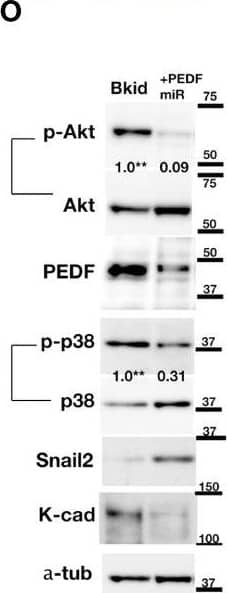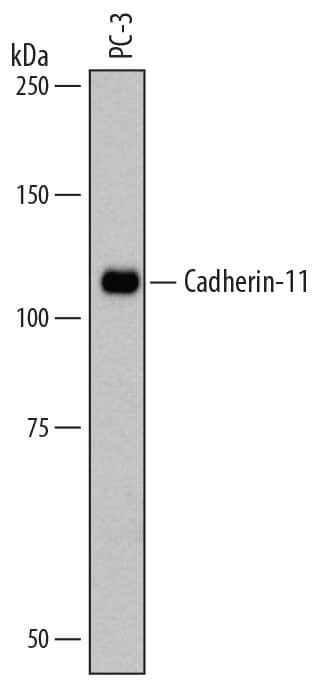Human Cadherin-11 Antibody
R&D Systems, part of Bio-Techne | Catalog # MAB1790

Key Product Details
Validated by
Species Reactivity
Validated:
Cited:
Applications
Validated:
Cited:
Label
Antibody Source
Product Specifications
Immunogen
Phe23-Thr617
Accession # AAA35622
Specificity
Clonality
Host
Isotype
Scientific Data Images for Human Cadherin-11 Antibody
Detection of Human Cadherin‑11 by Western Blot.
Western blot shows lysates of PC-3 human prostate cancer cell line. PVDF membrane was probed with 1 µg/mL of Mouse Anti-Human Cadherin-11 Monoclonal Antibody (Catalog # MAB1790) followed by HRP-conjugated Anti-Mouse IgG Secondary Antibody (Catalog # HAF007). A specific band was detected for Cadherin-11 at approximately 110 kDa (as indicated). This experiment was conducted under reducing conditions and using Immunoblot Buffer Group 1.Cadherin‑11 in Human Placenta.
Cadherin-11 was detected in immersion fixed paraffin-embedded sections of human placenta using Mouse Anti-Human Cadherin-11 Monoclonal Antibody (Catalog # MAB1790) at 8 µg/mL overnight at 4 °C. Tissue was stained using the Anti-Mouse HRP-DAB Cell & Tissue Staining Kit (brown; Catalog # CTS002) and counterstained with hematoxylin (blue). View our protocol for Chromogenic IHC Staining of Paraffin-embedded Tissue Sections.Detection of Human Cadherin‑11 by Simple WesternTM.
Simple Western lane view shows lysates of PC‑3 human prostate cancer cell line, loaded at 0.2 mg/mL. Specific bands were detected for Cadherin‑11 at approximately 114 & 137 kDa (as indicated) using 20 µg/mL of Mouse Anti-Human Cadherin‑11 Monoclonal Antibody (Catalog # MAB1790). This experiment was conducted under reducing conditions and using the 12-230 kDa separation system. Non-specific interaction with the 230 kDa Simple Western standard may be seen with this antibody.Applications for Human Cadherin-11 Antibody
Immunohistochemistry
Sample: Immersion fixed paraffin-embedded sections of human placenta
Simple Western
Sample: PC‑3 human prostate cancer cell line
Western Blot
Sample: PC‑3 human prostate cancer cell line
Reviewed Applications
Read 1 review rated 5 using MAB1790 in the following applications:
Formulation, Preparation, and Storage
Purification
Reconstitution
Formulation
Shipping
Stability & Storage
- 12 months from date of receipt, -20 to -70 °C as supplied.
- 1 month, 2 to 8 °C under sterile conditions after reconstitution.
- 6 months, -20 to -70 °C under sterile conditions after reconstitution.
Background: Cadherin-11
The cadherin superfamily comprises a large number of membrane glycoproteins with one or more cadherin repeats, which are involved in Ca2+ dependent cell-cell adhesion. The family can be subdivided into several major subgroups, including the type I and type II classical cadherins, desmosomal cadherins, protocadherins, seven transmembrane (Flamingo) cadherins, FAT-family cadherins, T-cadherin and other unclassified cadherins (1). Cadherin-11, also known as OB-cadherin, is a type II classical cadherin. Classical cadherins are type I transmembrane proteins with an N-terminal extracellular domain containing five tandem cadherin repeats and a C-terminal cytoplasmic domain with a characteristic sequence for binding to catenins. Type I cadherins (E-, N-, P-, R-, M-, and EP-cadherin) differ from type II cadherins (cadherin-5 to -12, -18 to -20 and -22) by the presence of the HAV tripeptide motif in the most N-terminal cadherin repeat (2). Classic cadherins mediate cell-cell adhesion preferentially via homotypic interactions and form adherens juctions that have beta-catenin and p120 (ctn) at the cytoplasmic side of the junction (3, 4). Homotypic cadherin interactions also transduce outside-in and inside-out cell signals. Cadherin signaling induces various cellular processes including cell motility, actin cytoskeleton reorganization, proliferation, and differentiation (3, 4). Cadherin-11 is expressed in a variety or normal tissues of mesodermal origin including areas of the kidney and brain, in normal osteoblasts, and in tumors of the stomach, kidney, colon, breast, and bone (osteosarcoma) (5, 6). It is also differentially expressed in the embryonic brain and may be important in regulating neural development. Human Cadherin-11 exhibits a unique mRNA splice site allowing for two forms of the protein to be expressed, a full-length 796 amino acid (aa) protein and a COOH terminus-truncated variant of 693 aa. The truncated variant has a unique cytoplasmic region due to a frameshift event (3). The full-length human and mouse Cadherin-11 share 97% homology at the aa sequence level.
References
- Angst, B.D. et al. (2001) J. Cell Sci. 113:629.
- Gessner, R. and R. Tauber (2000) Ann. N.Y. Acad. Sci. 915:136.
- Feltes, C.M. et al. (2002) Cancer Research. 62:6688.
- Wheelock, J.J. and K.R. Johnson (2003) Annu. Rev. Cell Dev. Biol. 19:207.
- Hoffmann, I. and R. Balling (1995) Dev. Biol. 169:337.
- Pishvaian, M.J. et. al. (1999) Cancer Research 59:947.
Alternate Names
Gene Symbol
UniProt
Additional Cadherin-11 Products
Product Documents for Human Cadherin-11 Antibody
Product Specific Notices for Human Cadherin-11 Antibody
For research use only



